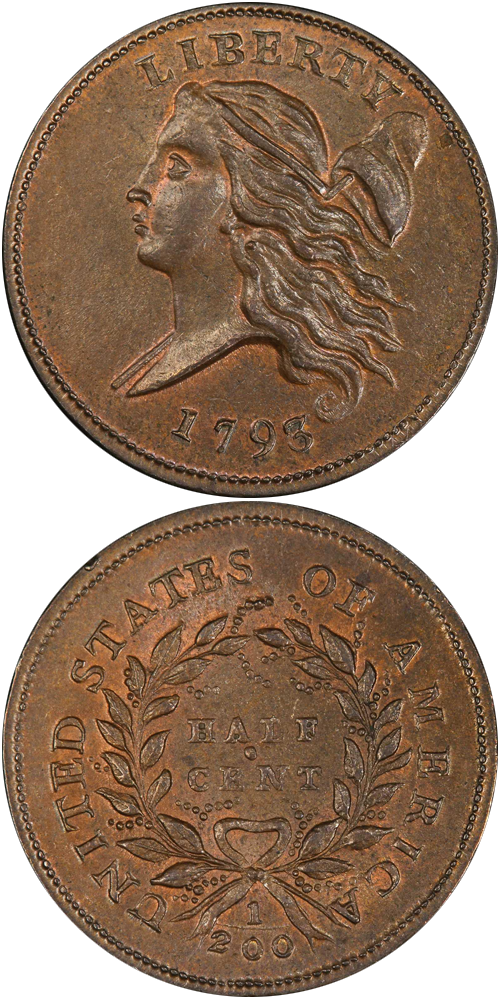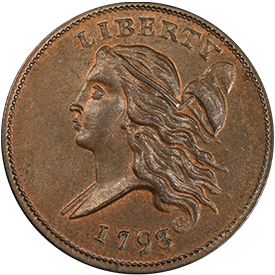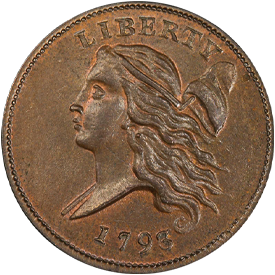Designed by: Adam Eckfeldt (?)
Issue Date: 1793
Composition: Copper
Diameter: 21.2 to 24.6 mm
Weight: 6.73 grams (104 grains)
Edge: Lettered TWO HUNDRED FOR A DOLLAR.
Business Strike Mintage: 35,334
Proof Mintage: None
The obverse of the design portrays Miss Liberty, with features engraved in detail, facing to the viewer's left, with a liberty cap on a pole behind her head. The word LIBERTY is above, and the date 1793 is below. A circle of beads is around the outer edge. The reverse consists of a wreath with leaves and berries, open at the top, and tied with a bow below. The denomination HALF CENTS is at the center, while UNITED STATES OF AMERICA and the fraction 1/200 comprises the border. A circle of beads is at the rim. Several die varieties were produced.
1793 half cents were coined in late spring or summer of the year, using a design adapted from the famous Libertas Americana medal issued in France. Walter Breen suggests that Robert Birch and Adam Eckfeldt produced the reverse dies, while Birch cut the obverse. The first delivery of struck pieces is said to have occurred on July 20, 1793.
Typically encountered 1793 half cents are apt to show extensive wear, with Fair, Good and Very Good examples representing the majority. Fine pieces are rare, Very Fine coins are rarer still, and pieces meriting the Extremely Fine or About Uncirculated designation are seldom met with. Occasionally an Uncirculated piece crosses the auction block. Many examples of 1793 half cents in grades from Fair through Fine show the words HALF CENT on the reverse weakly.
Only a few hundred 1793 half cents survive today. The coin is scarce in all grades and is considered to be a key issue.
Further Reading
The half cent series commences with the year 1793. Coins of this year are of particular interest as they are the only issues with Miss Liberty facing left and with the Liberty Cap design, the style the Guide Book designates as the Head Facing Left motif. The style was copied from the 1793 Liberty Cap large cent, which in tum was inspired by the French Libertas Americana medal issued a few years earlier. On the large cent, however, Miss Liberty is facing to the right.
Because 1793 half cents represent the only year of this design type, a specimen is necessary to complete a type set of United States coins. The low mintage of 35,334 pieces, its status as a needed type coin, and its position as the first year of the half cent denomination are factors that have combined to make the piece both popular and expensive. Most half cents seen today have the words HALF CENT weakly defined on the reverse. Indeed, concerning the reverse of one variety (C-1), Roger S. Cohen noted: "This die becomes warped in the center so that HALF CENT is seldom visible on specimens in less than Fine condition."
While a few scattered Uncirculated 1793 half cents have surfaced from time to time, a reasonable expectation for the collector with a generous budget is Very Fine to Extremely Fine. Most known examples are in lesser grades, Good to Fine, often with lightly porous or irregular surfaces. Most 1793 half cents are a medium or light brown color, in contrast with those of 1794, which nearly always are dark brown or black. These color differences are explained by the copper used by the Mint to strike the pieces. During the formative years of that coinage institution, copper was obtained from many different sources, including hoops from barrels, melted-down guns, roofing material, and other wrought objects. As a result, much of the metal was discolored or imperfect, creating characteristics that lend a special charm and personality to early half cents and large cents.








